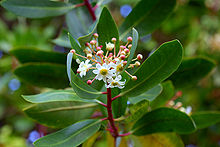
Back وينتراسيا ARZ Winteraceae AST Winteraceae Azerbaijani Winteraceae BS Winteràcies Catalan Winteraceae CEB Winterovité Czech Wintera-familien Danish Winteraceae German Vinteracoj Esperanto
| Winteraceae Temporal range:
| |
|---|---|

| |
| Drimys winteri | |
| Scientific classification | |
| Kingdom: | Plantae |
| Clade: | Tracheophytes |
| Clade: | Angiosperms |
| Clade: | Magnoliids |
| Order: | Canellales |
| Family: | Winteraceae R.Br. ex Lindl. |
| Genera[3] | |
Winteraceae is a primitive family of tropical trees and shrubs including 93[4] species in five genera.[3] It is of particular interest because it is such a primitive angiosperm family, distantly related to Magnoliaceae, though it has a much more southern distribution.[5] Plants in this family grow mostly in the southern hemisphere, and have been found in tropical to temperate climate regions of Malesia, Oceania, eastern Australia, New Zealand, Madagascar and the Neotropics,[5] with most of the genera concentrated in Australasia and Malesia. The five genera, Takhtajania, Tasmannia, Drimys, Pseudowintera, and Zygogynum s.l. all have distinct geographic extant populations. Takhtajania includes a single species, T. perrieri, endemic only to Madagascar, Tasmannia has the largest distribution of genera in Winteraceae with species across the Philippines, Borneo, New Guinea, Eastern Australia, and Tasmannia, Drimys is found in the Neotropical realm, from southern Mexico to the subarctic forests of southern South America, Pseudowintera is found only in New Zealand, and Zygogynum has species in New Guinea and New Caledonia.[6]
This family has been estimated to be anywhere from 105 to at least 35 million years ago.[3][7] Being one of few angiosperms forming persistent tetrads with prominent sculpturing, pollen of Winteraceae is rare but easy to identify in the fossil record.[7] Pollen samples found in Gabon may indicate that the family is at least 120 million years old,[8] but the association of these fossils with Winteraceae is uncertain.[7] Oldest unambiguous Winteraceae fossils are from the middle to late Albian of Israel (~110 million years old; described as Qatanipollis).[2] Pollen fossils indicate that the range has been much wider than it is now,[3] reaching north as far as Greenland during the Paleocene (Danian),[7] and disappearing from continental Africa (Cape Peninsula, South Africa) in the Miocene.[9] Equally characteristic is Winteraceae wood, which lacks xylem vessels in contrast to most other flowering plants.[10] Fossil Winteraceae wood has been found in the Late Cretaceous to Paleogene (c. 85–35 million years ago) of Antarctica (Santonian-Campanian),[11] western North America (Central Valley, California; Maastrichian)[12] and Europe (Helmstedt, Germany; Eocene).[13]
According to the 1998 APG I system, it did not belong to any order,[14] but it has since been placed in Canellales by the APG II, APG III and APG IV systems.[15][16][17]
| Winteraceae | |
- ^ "Canellales". www.mobot.org. Retrieved 20 July 2023.
- ^ a b WALKER, J. W.; BRENNER, G. J.; WALKER, A. G. (17 June 1983). "Winteraceous Pollen in the Lower Cretaceous of Israel: Early Evidence of a Magnolialean Angiosperm Family". Science. 220 (4603): 1273–1275. Bibcode:1983Sci...220.1273W. doi:10.1126/science.220.4603.1273. ISSN 0036-8075. PMID 17769368. S2CID 23964110.
- ^ a b c d Stevens, P.F. "Winteraceae". Angiosperm Phylogeny Website.
- ^ "Winteraceae R.Br. ex Lindl. | Plants of the World Online | Kew Science". Plants of the World Online. Retrieved 26 November 2021.
- ^ a b Hutchinson (1973). The Families of Flowering Plants. Oxford at the Clarendon Press.
- ^ Marquínez, Xavier; Lohmann, Lúcia G.; Salatino, Maria L. Faria; Salatino, Antonio; González, Favio (November 2009). "Generic relationships and dating of lineages in Winteraceae based on nuclear (ITS) and plastid (rpS16 and psbA-trnH) sequence data". Molecular Phylogenetics and Evolution. 53 (2): 435–449. doi:10.1016/j.ympev.2009.07.001. PMID 19580880.
- ^ a b c d Grímsson, Friðgeir; Grimm, Guido W.; Potts, Alastair J.; Zetter, Reinhard; Renner, Susanne S. (2018). "A Winteraceae pollen tetrad from the early Paleocene of western Greenland, and the fossil record of Winteraceae in Laurasia and Gondwana". Journal of Biogeography. 45 (3): 567–581. doi:10.1111/jbi.13154. ISSN 1365-2699. S2CID 91077162.
- ^ Doyle, J. A. 1999. The rise of angiosperms as seen in the African Cretaceous record. Pp. 3-29, in Scott, L., Cadman, A., & Verhoeven, R. (eds), Proceedings of the Third Conference on African Palynology, Johannesburg, 14–19 September 1997. A. A. Balkema, Rotterdam.
- ^ Coetzee, J. A.; Praglowski, J. (1988). "Winteraceae pollen from the miocene of the southwestern cape (south africa)". Grana. 27 (1): 27–37. doi:10.1080/00173138809427730. ISSN 0017-3134.
- ^ Cite error: The named reference
:1was invoked but never defined (see the help page). - ^ Poole, I (2000). "The First Record of Fossil Wood of Winteraceae from the Upper Cretaceous of Antarctica". Annals of Botany. 85 (3): 307–315. doi:10.1006/anbo.1999.1049. ISSN 0305-7364.
- ^ Page, Virginia M. (1979). "Dicotyledonous wood from the Upper Cretaceous of central California". Journal of the Arnold Arboretum. 60 (3): 223–249. doi:10.5962/p.185886. S2CID 134127930.
- ^ Gottwald, H (1992). "Hölzer aus marinen Sanden des oberen Eozän von Helmstedt (Niedersachsen)". Palaeontographica Abteilung B. 225: 27–103.
- ^ Angiosperm Phylogeny Group (1998). "An ordinal classification for the families of flowering plants". Annals of the Missouri Botanical Garden. 85 (4): 531–553. doi:10.2307/2992015. JSTOR 2992015.
- ^ Angiosperm Phylogeny Group (2003). "An update of the Angiosperm Phylogeny Group classification for the orders and families of flowering plants: APG II". Botanical Journal of the Linnean Society. 141 (4): 399–436. doi:10.1046/j.1095-8339.2003.t01-1-00158.x.
- ^ Angiosperm Phylogeny Group (2009). "An update of the Angiosperm Phylogeny Group classification for the orders and families of flowering plants: APG III". Botanical Journal of the Linnean Society. 161 (2): 105–121. doi:10.1111/j.1095-8339.2009.00996.x. hdl:10654/18083. ISSN 0024-4074.
- ^ Angiosperm Phylogeny Group (2016). "An update of the Angiosperm Phylogeny Group classification for the orders and families of flowering plants: APG IV". Botanical Journal of the Linnean Society. 181 (1): 1–20. doi:10.1111/boj.12385. ISSN 0024-4074.
© MMXXIII Rich X Search. We shall prevail. All rights reserved. Rich X Search